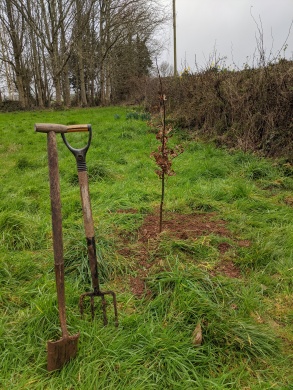Having booked my flights from Europe to Ushuaia in Argentina, from where my Antarctic adventure will start next year, it is time to look at my carbon footprint for this journey. A search on the internet provides me a myriad of options, which can be difficult when you don’t know where to start and who to trust.
The quick-fix research option for the un-initiated is to calculate my carbon footprint with a number of different calculators, offered by different ‘providers’ and see whether they more or less agree. It’s not a scientific or systematic approach, but I’ve decided to leave the in-depth analysis to another day.

It’s a long journey, more than half way around the globe, as these (crow’s) flight paths in red on Google Earth Pro images illustrate. By the way: the business of the ocean floor between Cape Horn, the Sandwich Islands and the Antarctic Peninsula is fascinating and I’ll write something about that another time.
The relevant distance, measured with Google Earth Pro, from London to Buenos Aires is 11100 km (7070 miles) and from there to Ushuaia another 2350 km (1450 miles). So the return distance, as the crow flies, amounts to some 27000 km, or 17000 miles.
According to Reforestum, I’ll need to offset 3.8 t CO2 for my flights. Reassuringly, this is remarkably close to the figure (4 t CO2) calculated by Carbonfootprint, whose tool allows to take radiative forcing¹ (also explained in a foot note) into account. Somewhat lower (2.8 t CO2) is the estimate of Conservation International. So, let’s take the worst case and settle for around 4 t CO2 equivalent emissions I need to offset.
A range of organisations have tools that allow you to calculate your annual CO2 emissions, and that get’s a little difficult to compare: results depend on how they account for energy use, whether they include food shopping and recycling habits, include specific details of your cars etc… I’ve had figures ranging from 10 t (Reforestum) to 15 t (WWF) and 20 t CO2 equivalent (United Nations; Carbonindependent).
I love trees. They are amazing in so many ways: size and shape, diversity and beauty, ecostystem services (air quality, health and wellbeing, timber…), and within the ecosystem they part-take in multi-disciplinary teamwork and communicate in mysterious ways…but I’ll lose myself in that some other time. Suffice to say here: my choice for carbon footprint offsetting are trees.

Woodland on the Devon bank of the Tamar estuary, England. (c) C Braungardt 2019.
To offset 4 t CO2 equivalent emissions I would need to plant around 24 m² woodland at a price tag of around £60 in the Picos de Europa (Reforestum).
I’m lucky, I’ve got a field, and as a household, we’ve already planted around 2100 m² native trees, a combination of two small stands of woodland (1600 m²) and an orchard surrounded by a dense hedge (2800 m²), which I guess, counts only for an equivalent of around 500 m² woodland. These trees offset around 25 ‘typical’ years for our household (but only 17 years of the footprint I’m accruing this year as a result of that long-haul flight).

The first of the oaks planted in the field today. Small start with great potential! (c) C Braungardt 2020.
But we have been around for more than 25 years and therefore have decided to plant around 200 m² new woodland, which starts to close the gap between our two existing stands. So, on this wet February morning between storms Ciara and Denis, a rather large (and woody) Valentine’s bouquet of oak, beach and chestnut were planted.
If you want to know more about carbon offsetting, watch this video by the United Nations and calculate your own footprint with some of the tools offered by the organisations listed in the References. Amazing what you can learn in a short time!
And perhaps there is an opportunity in your “back yard” to plant a tree, to get together with friends or involve the community and local school to buy a small field and plant trees with children – they are our future, and so are trees!
¹ Radiative forcing for the planet is the difference between the incoming energy from the sun and the amount of energy that is emitted by Earth into space. When the incoming energy is greater than the outgoing energy, the planet will warm. Changes in the reflective surface area of the planet, for example shrinking sea ice cover (ice reflects more energy than ocean water), will add to the warming of the atmosphere that is due to the increase in the atmospheric carbon dioxide concentration, which enhances the natural greenhouse effect. Read more about climate forcing at NOAA. When it comes to radiative forcing for carbon footprint calculations of air miles, radiative forcing may be accounting for the additional damage done by the emissions of aircraft at their high cruising altitude.
References
Carbonfootprint. 2020. An organisation that offers ‘certified emission reduction’ to off-setters’ and a choice of tree planting projects in the UK, Africa, South America and elsewhere, at country-specific prices. https://www.carbonfootprint.com/carbonoffset.html [accessed 10/02/2020]
Carbonindependent. 2020. A website supported by Ian Cambell, “launched in 2007 to give unbiased information on climate change, carbon dioxide and other greenhouse gas emissions, and how to become independent of fossil fuels.” https://www.carbonindependent.org/index.html [accessed 10/02/2020]
Conservation International. 2020. An organisation that claims “Since 1987, we have been fighting to protect nature for people“, has a wide portfolio of conservation projects and also offers a carbon footprint calulator and off-setting. https://www.conservation.org/carbon-footprint-calculator#/ [accessed 10/02/2020]
NOAA. 2020. Climate Forcing. Science and Information for a Climate-Smart Nation. https://www.climate.gov/maps-data/primer/climate-forcing [accessed 15/02/2020]
Reforestum. 2020. An organisation that aims to offset carbon dioxide (CO2) emissions through planting forests in areas that have been de-forested in the past, their first and only current project being the Picos de Europa, Spain). https://app.reforestum.com/ [accessed 10/02/2020]
United Nations Carbon Offset Platform. 2020. Branch of the United Nations. Does what it says on the tin. https://offset.climateneutralnow.org/footprintcalc [accessed 10/02/2020]
WWF. 2020. Branch of the World Wide Fund For Nature dealing with carbon footprint. https://footprint.wwf.org.uk/#/ [accessed 10/02/2020]
Featured Image
Aeroplane vapour trails over the Tamar estuary, Devon/Cornwall in the UK. (c) C Braungardt 2020.


I love that you’re planting trees in your own back yard. You really do “walk your talk”
LikeLike
We’ll, Sue, I’m trying to make the best out of this adventure. No point feeling guilty, much better to take action. The Antarctic Peninsula just smashed the January temperature maximum, followed by another record in February: over 20 C!!! Can’t remain unnoticed.
LikeLike
Pingback: Utter Frivolity | Challenging Habitat
Pingback: Outdoor Daily | Challenging Habitat